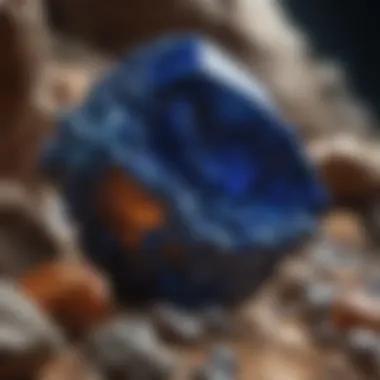Unveiling the Enchanting Universe of Blue Rocks: A Comprehensive Exploration


Rock and Fossil Identification
Blue rocks come in a fascinating array of types, each with distinct characteristics that make them stand out in the world of geology. Two of the prominent blue rocks that intrigue collectors are azurite and blue calcite. Azurite, with its deep blue hue and striking crystals, often forms in oxidation zones of copper ore deposits. Blue calcite, on the other hand, showcases a serene blue color and is known for its calming properties. When identifying these rocks, it's essential to look for specific features such as crystal shape, color intensity, and cleavage patterns. Utilizing tools like a hardness tester, magnifying glass, and streak plate can aid in the identification process, offering enthusiasts a deeper insight into the world of blue rocks.
Introduction to Blue Rocks
Blue rocks, with their stunning hues and fascinating geological formations, have captivated the interest of scientists, collectors, and enthusiasts alike. In this comprehensive guide exploring the mesmerizing world of blue rocks, we delve into the intricate details and unique qualities that make these rocks truly exceptional. From the deep azure of azurite to the calming tones of blue calcite, each rock tells a story that dates back millions of years, offering insights into the Earth's geological history.
Understanding the Appeal of Blue Rocks
What sets blue rocks apart from their counterparts is not just their striking color but also the allure they exude. Blue rocks evoke a sense of tranquility and depth, drawing individuals into their world of mystery and beauty. The appeal of blue rocks lies in their ability to intrigue and inspire, sparking curiosity about the geological processes that created such stunning formations. Whether used for ornamental purposes or admired for their natural beauty, blue rocks have a timeless charm that continues to captivate.
Significance of Blue Color in Geology
In the geological realm, the color blue carries significant meaning, symbolizing elements such as purity, stability, and depth. When blue manifests in rocks, it often indicates the presence of specific minerals or chemical compositions that have undergone unique geological processes. Understanding the significance of the blue color in geology allows geologists and enthusiasts to decipher clues about the rock's formation and history. Blue rocks stand out not only for their visual appeal but also for the valuable insights they offer into the Earth's geological past, making them a cornerstone of geological studies and exploration.
Azurite: The Gem of the Blue World
Azurite, a mesmerizing gem often referred to as the 'Gem of the Blue World,' plays a prominent role in this article as we delve into the enchanting realm of blue rocks. Its captivating deep blue hue and intricate formations make it a gemstone highly sought after by rock and mineral enthusiasts alike. Throughout history, azurite has intrigued geologists and jewelry artisans with its unique properties and striking appearance.


Formation and Characteristics of Azurite
With a chemical composition of copper carbonate hydroxide, azurite forms in the oxidized zones of copper ore deposits, presenting as stunning deep blue crystals. Its distinct color arises from the copper ions within its structure, reflecting a rich azure hue that changes based on light angles and mineral purity. Azurite crystals exhibit a prismatic or massive form, showcasing intricate patterns and shades of blue that mesmerize onlookers.
Uses and Value of Azurite in Jewelry and Art
The historical significance and aesthetic appeal of azurite have made it a staple in jewelry and art for centuries. Renowned for its intense blue color and fine-grained texture, azurite is often fashioned into cabochons, beads, and intricate carvings to create exquisite pieces of jewelry. Its value lies not only in its beauty but also in the metaphysical properties believed to enhance intuition and connection to higher realms. Artists appreciate azurite for its versatility in mixed media art, bringing a touch of elegance and mystery to their creations.
Blue Calcite: Tranquility in Stone Form
In the vast array of blue rocks, Blue Calcite stands out for its tranquil essence and unique geological properties, making it a topic of great significance within this article. Blue Calcite, with its soothing blue hues, captivates both geology enthusiasts and spiritual seekers alike. Its presence in this exploration highlights the diverse nature of blue rocks and their remarkable contributions to the fascinating world of geology.
Geological Origin and Features of Blue Calcite
The geological origin of Blue Calcite traces back to its formation in sedimentary and metamorphic environments, known for its delicate yet striking crystalline structures. This section delves into the intricate details of how environmental conditions and mineral composition interacted over millennia to create the serene beauty of Blue Calcite. By examining the distinctive features such as its color variations, transparency levels, and prevalent cleavage patterns, readers gain a deeper understanding of the geological processes that shaped this tranquil stone.
Metaphysical Properties and Healing Benefits
Beyond its geological origins, Blue Calcite also boasts metaphysical properties that have captured the interest of crystal healers and spiritual practitioners. This section explores the perceived healing benefits associated with Blue Calcite, from its calming effects on the emotional body to its believed abilities in enhancing communication and promoting inner peace. By elucidating the metaphysical aspects of Blue Calcite, readers can appreciate the holistic significance of this stone beyond its physical attributes, solidifying its position as a multifaceted gem in the realm of blue rocks.
Sodalite: The Stone of Logic and Communication


Composition and Visual Appeal of Sodalite
With a distinct composition primarily consisting of sodium, aluminum, silicon, and chlorine, Sodalite showcases a mesmerizing interplay of deep blue shades mingled with streaks of white calcite. This striking visual appeal makes Sodalite a sought-after specimen in the world of minerals and gemstones. Its fine-grained structure enhances its glossy finish, adding to its allure as a decorative and metaphysical gem.
Historical Significance and Cultural Uses
Through centuries of history, Sodalite has held a special place in various cultures and civilizations. Known for enhancing rational thinking and clear communication, Sodalite has been associated with intellectual pursuits and harmonious dialogue. Ancient civilizations revered Sodalite for its ability to stimulate the mind and encourage honesty and integrity in communication.
Sodalite's cultural significance extends to modern times, where it is widely used in jewelry-making, crystal healing practices, and Feng Shui applications. Its deep blue color symbolizes wisdom, logic, and effective communication, making it a popular choice for individuals seeking mental clarity and emotional balance.
Blue Lace Agate: Elegance in Every Layer
In the vast realm of blue rocks detailed in this article, Blue Lace Agate emerges as a gem of unparalleled elegance and sophistication. This section unveils the importance and allure of Blue Lace Agate, shedding light on its distinct characteristics and the significance it holds within the world of gemstones. Blue Lace Agate is celebrated for its exquisite layers of blue and white, reminiscent of delicate lacework, making it a sought-after treasure for collectors and enthusiasts alike.
Unique Patterns and Geological Formation
The Unique Patterns and Geological Formation of Blue Lace Agate are a testimony to the wonders of nature's creativity. The intricate bands and delicate swirls present in Blue Lace Agate are formed through a process of deposition and crystallization that spans millions of years. This section delves into the geological factors that influence the formation of Blue Lace Agate, highlighting the conditions necessary for the creation of its mesmerizing patterns. Understanding the geological genesis of Blue Lace Agate adds a fascinating layer of appreciation for this enchanting stone.
Spiritual Meanings and Emotional Healing
Blue Lace Agate extends beyond its physical beauty to offer profound spiritual meanings and emotional healing properties. This segment explores the metaphysical aspects of Blue Lace Agate, delving into its reputation as a stone of tranquility and communication. The gentle energy of Blue Lace Agate is believed to soothe the mind, promote effective communication, and foster inner peace. By unraveling the spiritual significance and emotional healing benefits of Blue Lace Agate, this article provides a holistic perspective on the multifaceted nature of this captivating gemstone.


Celestite: The Celestial Blue Crystal
In the enchanting realm of blue rocks, Celestite stands out as a celestial beauty, captivating collectors and enthusiasts alike with its stunning blue hues and ethereal qualities. This section delves into the significance of Celestite within the broader context of blue rocks, highlighting its unique characteristics and mystical allure.
Crystal Structure and Clarity of Celestite
Celestite, also known as celestine, is celebrated for its remarkable crystal structure characterized by delicate prismatic formations that shimmer with a celestial glow. The crystal's clarity is unparalleled, allowing light to pass through and illuminate its internal structure, creating a mesmerizing effect that symbolizes purity and divine connection.
Connection to Divine Energies and Meditation
Beyond its physical beauty, Celestite is revered for its spiritual significance, believed to possess a strong connection to divine energies and higher realms. When used in meditation, this crystal is said to facilitate communication with angelic beings and enhance spiritual awareness, promoting inner peace and a sense of serenity. Its calming vibrations make it a favored tool for those seeking to deepen their meditation practice and explore the depths of the subconscious mind.
Conclusion
As we conclude our expedition through this expansive world of blue rocks, it becomes apparent that these stones are more than just geological formations; they are a testament to the wonders of the Earth and the artistry of nature. The significance of our exploration lies not only in marveling at the external beauty of these rocks but also in understanding the intricate processes that have sculpted them over millennia. By appreciating the diversity and beauty of blue rocks, we gain a deeper appreciation for the Earth's natural marvels and sharpen our sense of curiosity for the mysteries that await beneath the surface.
Appreciating the Diversity and Beauty of Blue Rocks
In delving into the realm of blue rocks, it is impossible not to be captivated by the sheer diversity and beauty that these stones encapsulate. From the vibrant hues of azurite to the calming tones of blue calcite, each blue rock presents a unique visual spectacle that reflects millions of years of geological evolution. The intricate patterns, mesmerizing colors, and varied textures make blue rocks a treasure trove for both enthusiasts and collectors alike.
Beyond their aesthetic appeal, blue rocks also exhibit a wide range of metaphysical properties and healing benefits that have been revered by ancient civilizations and modern practitioners alike. The soothing vibrations of blue lace agate, the cosmic clarity of celestite, and the harmonizing energies of sodalite all contribute to the allure of these stones beyond their external beauty. By appreciating the diversity of blue rocks, we open ourselves to a world of interconnected energies and profound spiritual meanings that transcend the physical realm.
Continuing the Exploration of Geological Wonders
While our journey through the world of blue rocks has been enlightening, it is merely the beginning of a vast and uncharted terrain of geological wonders waiting to be further explored. The Earth is teeming with an abundance of minerals, rocks, and fossils, each holding its own story and significance in the tapestry of geology. By continuing our exploration of these geological wonders, we not only deepen our understanding of the Earth's history but also contribute to the preservation and appreciation of our planet's natural heritage.
As we push the boundaries of our knowledge and venture into new geological realms, we pave the way for future discoveries and scientific advancements that can reshape our understanding of the world around us. By embracing the spirit of exploration and inquiry, we not only satisfy our intellectual curiosity but also contribute to the ongoing dialogue between humanity and nature. Let us continue to marvel at the geological wonders that surround us and embark on new adventures in the captivating world of rocks and minerals.







